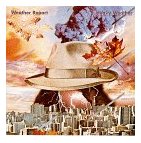
Mahavishnu Orchestra
Birds of Fire
Released 1973
John McLaughlin, guitar; Rick Laird, bass; Billy Cobham, drums; Jerry Goodman,
violin; Jan Hammer, keyboards
My guess is that lots of newcomers to jazz are
already fans of rock music. If this describes you, then the Mahavishnu Orchestra is an ideal way to acclimate yourself.
In the late 1960s and early 1970s, jazz musicians began incorporating the electrified instruments and aggressive sounds of
rock into their playing, creating a new jazz style known as fusion. John McLaughlin, a guitarist who had earlier played
with Miles Davis, formed the Orchestra in 1970. It quickly became the jazz world's premier fusion group.
The quintet drew not only on rock and jazz, but also on funk, country, and folk music. The result sounds something
like a really sophisticated Jimi Hendrix album--indeed, had he not died, this is easily the direction Hendrix himself
might have taken.
The title track, Birds of Fire, opens
with a slowly banging gong, followed by a wash of guitar arpeggios, and then Jerry Goodman's electric violin and McLaughlin's
electric guitar set the mood for the album with fiery, uninhibited solos. Other highlights are the happy, country-tinged Open
Country Joy, whose final third includes some infectious Appalachian fiddle work, and Miles Beyond, with its Sly and the
Family Stone-style keyboard groove, breathtakingly sublime plucked-string violin interlude, and its final break-neck
paced guitar solo.
The album's climactic centerpiece, however, is
One Word, nearly 10 minutes of high-energy bass-propelled funk. While bassist Rick Laird really outdoes himself, I think
drummer Billy Cobham also does a great job, locking in with Laird to create an unstoppable groove, although his drum solo
near the end of the song is excessive at two minutes. One might think that adding a wah-wah pedal to Goodman's violin
on the song would be a little over the top, but in fact it suits the song perfectly.
The spaced-out Celestial Terrestial Commuters and
the dark electric ballad Sanctuary are also solid songs. Less effective is Thousand Island Park, which opens with
a "baroque" theme, segues into a "flamenco" theme apart half-way through, and then returns to the "baroque" theme to close.
The obvious archaisms are forced and artificial, and the song only gets in the way of the album's otherwise swift pacing.
Sapphire Bullets of Pure Love, although thankfully only 22 seconds, is particularly obnoxious, a useless bit of backwards
tape inserted for no apparent reason (I believe the bit played backwards is from Celestial Terrestial Commuters, but
never mind.)
Still, overall the album is superb. The 1970s
was not an era of subtlety, and this album is no exception, but its unabashed volume, passion, and electricity are
a real joy, and I recommend it highly.
Grade: A-
(Reviewed 6/20/04)
|
 |
|
|
|
 |

Weather Report
Heavy Weather
Released 1977
Joe Zawinul, piano and keyboards; Wayne Shorter, soprano and tenor saxophone; Jaco Pastorius, bass and Mandocello; Alex
Acuna, drums and percussion; Manolo Badrena, congas and percussion
Weather Report's Heavy Weather is notable in jazz history for two things.
One, it was the first full album with the 25-year old Jaco Pastorius, who recognized the possibility of playing
the electric bass as a melodic instrument. Indeed, the tone of his fretless bass on the album is bright, almost
brassy, and his solos flow as naturally as those from any saxophone or trumpet.
And two, the album opens with the song Birdland, one of the few jazz songs of the past
several decades to cross over to the pop charts. And it's easy to see why, for Birdland has an infectious energy,
propelled by that explosive bass playing, and joined by Wayne Shorter's joyous saxophone and Joe Zawinul's keyboards, which
he plays here like a synthesized big band brass section. The big, busy, happy mess of a song reminds me of the neon
and never-ending movement of a bustling urban street.
Unfortunately, the rest of the album does not live up to the promise of the first song, although
it does have a few other high points. I like Havona, where a mid-tempo groove gives plenty of room for Pastorius's
burbling bass figures and interesting little interjections (too short to call them solos) by piano and sax, as well as some
great cymbal work by Alex Acuna. Palladíum has a funky bass line and is the only song on this bass-and-keyboard-dominated
album to give Shorter the chance for a real sax solo. The otherwise underutilized Manolo Badrena also turns in some
nice work on the congas on this song. And on The Juggler, Zawinul builds layers of synthesized keyboards
into a beautiful, intricate fantasy soundscape.
On the other hand, A Remark You Made is an unbearably syrupy ballad with lots
of clichéd keyboard and sax. Although it closes with an intriguing electric piano solo, it's hard to imagine many
people sitting through the six minutes it takes to get there. Teen Town, basically an extended bass solo over
a disco beat, and Harlequin, a bass-heavy, spaced-out ballad, are disjointed and feel more like technical exercises
than real songs. Finally, Rumba Mamá, apparently recorded live although the liner notes make no mention of
it, is little more than two minutes of shouting in Spanish with some Latin percussion. Judging from the crowd noise
on the song, it must have been impressive in concert, but I guess you had to be there.
While it has one truly inspired song and a few other other quite good ones,
on the whole Heavy Weather is uneven. I think many listeners may also find that some of the synthesized keyboard
sounds dated--after all, sounds that were cutting-edge in 1977 can be made now on any cheap Casio. Not a bad album,
but no longer the landmark it seemed upon its original release.
Grade: B-
(Reviewed 3/14/04)
|
 |
|
|
|

